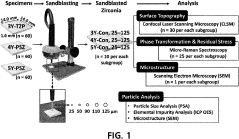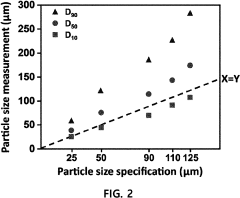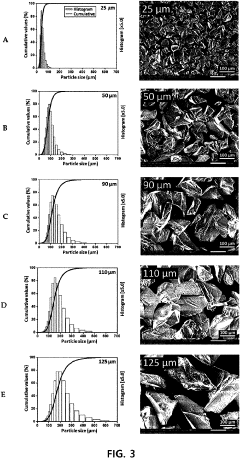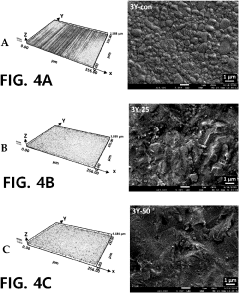Zirconia Processing Techniques: Enhancing Material Quality
Zirconia Evolution
Zirconia processing techniques have undergone significant evolution since the material's discovery in the late 18th century. Initially, zirconia was primarily used in its natural form, with limited applications due to its inherent properties. The early 20th century saw the first major breakthrough with the development of stabilized zirconia, which expanded its potential uses in various industries.
In the 1960s and 1970s, researchers made substantial progress in understanding the phase transformations of zirconia, particularly the tetragonal to monoclinic transformation. This knowledge led to the development of partially stabilized zirconia (PSZ) and tetragonal zirconia polycrystals (TZP), which exhibited superior mechanical properties compared to fully stabilized zirconia.
The 1980s marked a significant milestone with the introduction of yttria-stabilized zirconia (YSZ), which became a game-changer in the field of advanced ceramics. YSZ offered an exceptional combination of strength, toughness, and chemical stability, making it ideal for applications in harsh environments.
The 1990s and early 2000s saw advancements in processing techniques, including the refinement of powder synthesis methods and the development of novel sintering approaches. Techniques such as hot isostatic pressing (HIP) and spark plasma sintering (SPS) enabled the production of zirconia components with enhanced density and improved mechanical properties.
In recent years, the focus has shifted towards nanostructured zirconia materials. Researchers have developed methods to produce zirconia nanoparticles and nanocomposites, which exhibit unique properties and open up new possibilities for applications in areas such as biomedicine and energy storage.
The advent of additive manufacturing technologies has also impacted zirconia processing. 3D printing of zirconia components has become increasingly feasible, allowing for the creation of complex geometries and customized parts that were previously difficult or impossible to produce using traditional manufacturing methods.
Current research in zirconia processing techniques is centered on enhancing material quality through precise control of microstructure and composition. Advanced characterization techniques, such as high-resolution electron microscopy and synchrotron-based X-ray analysis, have enabled researchers to gain deeper insights into the material's structure-property relationships, guiding the development of optimized processing routes.
Looking ahead, the evolution of zirconia processing techniques is likely to continue in several directions. These include the development of multi-functional zirconia-based materials, the integration of zirconia in advanced composite systems, and the exploration of novel processing methods that can further improve material performance while reducing energy consumption and environmental impact.
Market Applications
Zirconia has found widespread applications across various industries due to its exceptional properties, including high strength, wear resistance, and biocompatibility. In the dental sector, zirconia has revolutionized prosthetic dentistry, offering superior aesthetics and durability for crowns, bridges, and implants. The material's natural appearance and ability to withstand high masticatory forces have made it a preferred choice for both patients and dental professionals.
The aerospace industry has also embraced zirconia, particularly in thermal barrier coatings for jet engine components. These coatings provide crucial protection against extreme temperatures, extending the lifespan of critical engine parts and improving overall efficiency. As aircraft manufacturers strive for lighter and more fuel-efficient designs, zirconia's role in advanced ceramics continues to grow.
In the electronics sector, zirconia plays a vital role in the production of solid oxide fuel cells (SOFCs). These energy conversion devices offer high efficiency and low emissions, making them attractive for both stationary power generation and automotive applications. Zirconia's excellent ionic conductivity at high temperatures makes it an ideal electrolyte material for SOFCs, driving research and development in this field.
The automotive industry has increasingly incorporated zirconia into various components, such as oxygen sensors and catalytic converters. Zirconia-based oxygen sensors help optimize engine performance and reduce emissions, while zirconia in catalytic converters enhances their durability and efficiency in converting harmful exhaust gases into less harmful substances.
In the medical field, zirconia has gained prominence in orthopedic implants, particularly for hip and knee replacements. Its biocompatibility, high strength, and wear resistance make it an excellent alternative to traditional materials like titanium. Zirconia implants have shown promising results in reducing wear debris and improving long-term outcomes for patients.
The nuclear industry utilizes zirconia in fuel rod cladding due to its low neutron absorption cross-section and resistance to corrosion in high-temperature environments. This application is critical for maintaining the safety and efficiency of nuclear reactors.
As advanced manufacturing techniques continue to evolve, new applications for zirconia are emerging in fields such as optics, cutting tools, and high-performance ceramics. The ongoing research into enhancing zirconia's properties and processing techniques is expected to further expand its market applications, driving innovation across multiple industries and contributing to the development of more efficient, durable, and sustainable products.
Technical Challenges
Zirconia processing techniques face several significant challenges that hinder the enhancement of material quality. One of the primary obstacles is the control of grain size and distribution during sintering. As zirconia undergoes phase transformations at high temperatures, managing the grain growth becomes crucial to maintain desired mechanical properties. Achieving uniform grain size distribution is particularly challenging, as it directly impacts the material's strength, toughness, and wear resistance.
Another major hurdle in zirconia processing is the prevention of porosity and defects. The sintering process, while essential for densification, can lead to the formation of unwanted pores or structural defects if not carefully controlled. These imperfections can significantly compromise the material's performance, especially in applications requiring high strength and reliability.
The stabilization of zirconia's crystal structure presents an ongoing challenge. Pure zirconia undergoes phase transformations that can cause volume changes and cracking. While the addition of stabilizing oxides like yttria or ceria helps maintain the desired crystal structure, achieving the optimal balance of stabilizers without compromising other properties remains a complex task.
Temperature control during processing is another critical challenge. Zirconia requires high sintering temperatures, typically above 1400°C, which can lead to energy inefficiency and potential contamination from furnace components. Maintaining precise temperature profiles throughout the sintering cycle is essential for achieving consistent material properties but can be technically demanding.
The selection and preparation of raw materials also pose significant challenges. Impurities in starting powders can dramatically affect the final properties of zirconia. Ensuring high-purity precursors and developing effective methods for their uniform mixing and dispersion are ongoing areas of research and development.
Lastly, the scalability of advanced processing techniques presents a considerable challenge. While laboratory-scale processes may yield high-quality zirconia, translating these methods to industrial-scale production while maintaining material quality and cost-effectiveness is a significant hurdle. This includes challenges in maintaining uniform properties across large batches and developing efficient, reproducible manufacturing processes.
Addressing these technical challenges is crucial for advancing zirconia processing techniques and enhancing material quality. Ongoing research focuses on innovative sintering methods, precise control of processing parameters, and the development of new additives and stabilizers to overcome these obstacles and unlock the full potential of zirconia in various applications.
Current Techniques
01 Composition and structure control
Controlling the composition and structure of zirconia materials is crucial for achieving high quality. This includes optimizing the ratio of zirconia to other components, controlling grain size, and managing phase transformations. Proper control of these factors can lead to improved mechanical properties, thermal stability, and overall performance of the zirconia material.- Composition and structure optimization: Improving zirconia material quality through optimizing its composition and structure. This includes controlling the grain size, porosity, and phase composition to enhance mechanical properties and stability. Advanced processing techniques may be employed to achieve desired microstructures.
- Sintering process refinement: Refining the sintering process to improve zirconia material quality. This involves optimizing sintering temperature, time, and atmosphere to achieve better densification and grain growth control. Advanced sintering techniques such as spark plasma sintering or hot isostatic pressing may be utilized.
- Dopant addition and stabilization: Enhancing zirconia material quality through the addition of dopants and stabilizers. This includes incorporating elements like yttria, ceria, or magnesia to stabilize specific crystal phases and improve mechanical and thermal properties. The type and concentration of dopants are carefully controlled to achieve desired characteristics.
- Surface treatment and coating: Improving zirconia material quality through surface treatments and coatings. This involves techniques such as ion implantation, plasma spraying, or chemical vapor deposition to modify surface properties. These treatments can enhance wear resistance, corrosion resistance, and biocompatibility of zirconia materials.
- Quality control and characterization: Implementing advanced quality control and characterization methods to ensure high-quality zirconia materials. This includes using techniques such as X-ray diffraction, electron microscopy, and mechanical testing to assess material properties and identify defects. Developing standardized testing protocols and acceptance criteria for zirconia materials in various applications.
02 Sintering process optimization
The sintering process plays a vital role in determining the final quality of zirconia materials. Optimizing parameters such as temperature, pressure, and duration can enhance densification, reduce porosity, and improve the material's mechanical and optical properties. Advanced sintering techniques may be employed to achieve superior quality zirconia products.Expand Specific Solutions03 Dopant and additive incorporation
Incorporating specific dopants and additives can significantly enhance the quality of zirconia materials. These additives can stabilize certain crystalline phases, improve mechanical properties, increase thermal resistance, and enhance optical characteristics. Careful selection and precise control of dopant concentrations are essential for achieving desired material properties.Expand Specific Solutions04 Surface treatment and finishing
Surface treatment and finishing processes are crucial for improving the quality of zirconia materials, especially for applications requiring high precision or specific surface properties. Techniques such as polishing, coating, and surface modification can enhance wear resistance, reduce friction, improve biocompatibility, and optimize optical properties of zirconia components.Expand Specific Solutions05 Quality control and characterization methods
Implementing robust quality control measures and advanced characterization techniques is essential for ensuring high-quality zirconia materials. This includes using various analytical methods to assess purity, composition, microstructure, mechanical properties, and performance characteristics. Continuous monitoring and improvement of these processes contribute to consistent and superior zirconia material quality.Expand Specific Solutions
Industry Leaders
The zirconia processing techniques market is in a growth phase, driven by increasing demand in various industries. The market size is expanding, with a projected CAGR of 6.5% from 2021 to 2026. Technologically, the field is advancing rapidly, with companies like Tosoh Corp., 3M Innovative Properties Co., and Saint-Gobain Ceramics & Plastics, Inc. leading innovation. These firms are developing advanced processing methods to enhance zirconia's material quality, focusing on improved strength, durability, and versatility. The competitive landscape is diverse, with both established players and emerging companies contributing to technological advancements, indicating a dynamic and evolving market.
Tosoh Corp.
Daiichi Kigenso Kagaku Kogyo Co., Ltd.
Key Innovations
- A surface treatment method involving polishing zirconia surfaces with tetragonal and cubic phases and then sandblasting them using alumina particles of specific sizes (100 to 120 µm for 3Y-TZP, 80 to 100 µm for 4Y-PSZ, and 10 to 50 µm for 5Y-PSZ) to optimize surface topography and residual stress, using a nozzle-equipped sandblasting apparatus with controlled pressure and distance.
- A process involving the agglomeration of zirconia powder through build-up granulation to create a granulate that is flowable and can be processed without binders, allowing for direct sintering and reduced material loss, using a suspension with minimal organic components and agglomerating without the addition or removal of liquids.
Environmental Impact
The environmental impact of zirconia processing techniques is a critical consideration in enhancing material quality. The production of zirconia involves several stages, each with potential environmental implications. Mining and extraction of zircon sand, the primary raw material, can lead to land degradation and habitat disruption. The subsequent refining process often requires high temperatures and energy-intensive operations, contributing to increased carbon emissions and energy consumption.
Chemical treatments used in zirconia processing may result in the generation of hazardous waste and effluents. These by-products, if not properly managed, can contaminate soil and water resources. Additionally, the use of strong acids and bases in certain processing methods poses risks of chemical spills and worker exposure to harmful substances.
However, advancements in zirconia processing techniques are addressing these environmental concerns. Closed-loop systems are being implemented to minimize water usage and reduce wastewater discharge. Recycling and reuse of process chemicals are becoming more common, decreasing the overall environmental footprint of production.
Energy efficiency improvements in furnace design and operation are reducing the carbon intensity of zirconia manufacturing. Some facilities are transitioning to renewable energy sources, further mitigating the environmental impact of high-temperature processes. Implementation of dust collection systems and improved filtration technologies are helping to control air emissions and particulate matter release.
Innovative processing methods, such as hydrothermal synthesis and sol-gel techniques, offer more environmentally friendly alternatives to traditional high-temperature calcination. These approaches often require lower processing temperatures and can result in reduced energy consumption and emissions.
Life cycle assessments of zirconia production are increasingly being conducted to identify areas for environmental improvement. This holistic approach considers the entire production chain, from raw material extraction to final product disposal, enabling manufacturers to optimize their processes for sustainability.
As regulations on industrial emissions and waste management become more stringent, zirconia producers are investing in cleaner technologies and pollution control measures. This regulatory pressure, combined with growing consumer demand for environmentally responsible products, is driving the industry towards more sustainable practices.
In conclusion, while zirconia processing has historically had significant environmental impacts, ongoing technological advancements and a shift towards sustainable practices are mitigating these effects. The industry's focus on enhancing material quality is increasingly aligned with efforts to reduce environmental footprint, leading to more eco-friendly zirconia production methods.
Quality Standards
Quality standards play a crucial role in the processing and production of zirconia materials, ensuring consistency, reliability, and optimal performance across various applications. These standards encompass a wide range of parameters and testing methods to evaluate the quality of zirconia products throughout the manufacturing process.
One of the primary quality standards for zirconia processing is the assessment of particle size distribution. This parameter significantly influences the material's mechanical properties, sintering behavior, and overall performance. Advanced techniques such as laser diffraction and dynamic light scattering are employed to measure particle size with high precision, ensuring that the zirconia powder meets the specified size range for its intended application.
Chemical purity is another critical quality standard in zirconia processing. Impurities can significantly affect the material's properties and performance, particularly in high-tech applications such as dental implants or fuel cells. X-ray fluorescence spectroscopy and inductively coupled plasma mass spectrometry are commonly used to analyze the chemical composition and detect trace impurities in zirconia materials.
The crystalline structure of zirconia is a key quality indicator, as it directly impacts the material's mechanical and thermal properties. X-ray diffraction analysis is widely employed to determine the crystal phase composition and ensure that the desired phase (e.g., tetragonal or cubic) is achieved during processing. This is particularly important for applications requiring specific zirconia polymorphs.
Density and porosity measurements are essential quality standards for evaluating the structural integrity of zirconia products. Techniques such as Archimedes' method and mercury porosimetry are used to assess these parameters, which influence the material's strength, thermal conductivity, and other physical properties.
Mechanical properties, including hardness, fracture toughness, and flexural strength, are critical quality standards for zirconia materials. Standardized testing methods, such as Vickers indentation and four-point bending tests, are employed to evaluate these properties and ensure that the processed zirconia meets the required specifications for its intended application.
Surface finish and dimensional accuracy are important quality standards, particularly for zirconia components used in precision engineering or medical applications. Advanced metrology techniques, including optical profilometry and coordinate measuring machines, are utilized to verify that the processed zirconia parts meet the specified tolerances and surface roughness requirements.
To maintain consistent quality across production batches, statistical process control methods are implemented as part of the quality standards. This involves continuous monitoring of key process parameters and material properties, allowing for early detection of deviations and prompt corrective actions.



